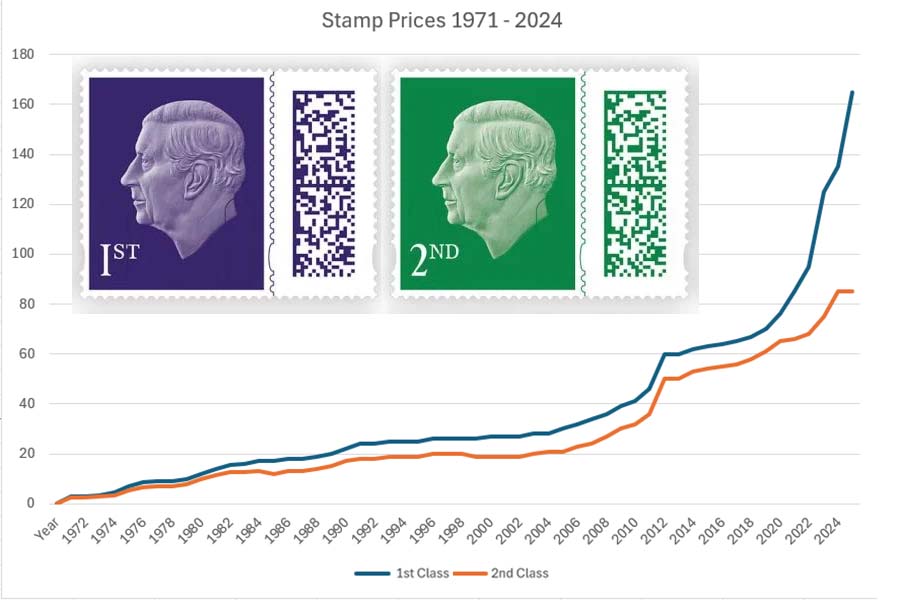History of the Cost for 1st Class Postage Stamps Over the Years
The cost of sending a simple letter has been a reliable indicator of postal service trends and even inflation. First-class postage stamps are familiar items to most people, but few consider how this seemingly minor cost has evolved over time. The history of first-class postage rates reflects broader societal and economic changes, showcasing how the USPS has adapted to demand, economic shifts, and changes in mail volume.
In this blog, we’ll walk through the journey of first-class postage stamp prices, highlighting pivotal moments that have shaped the modern-day postal system. Along the way, we’ll answer questions like “What is first class letter weight” and explore the implications of the common “return to sender USPS” process.
The Early Days: Inception of the U.S. Postal Service and Stamp Pricing
The USPS was officially established in 1775, and while it’s hard to imagine, the postal system has been operating for almost 250 years. Early on, sending mail was a luxury, with rates determined by the distance the letter traveled rather than by weight. It wasn’t until 1847 that the U.S. Postal Service introduced postage stamps as a way to simplify the payment process. The first stamps were issued in five-cent and ten-cent denominations and were used to pay for mail based on weight.
The first notable shift in postage pricing occurred in 1863 when the rate was standardized to 3 cents for domestic letters, a rate that remained in place for decades. This set the stage for the practice of using first-class postage for letters under a certain weight—a principle that would continue into modern times.
The Era of the Penny Postage
In 1883, the U.S. government reduced the cost of sending first-class letters to 2 cents. This change reflected the nation’s growing population and the USPS’s efforts to make postal services affordable and accessible to a wider audience. Known as the “penny postage” period, this rate persisted until 1917, when World War I and inflationary pressures led to the first increase in nearly four decades. The cost rose to 3 cents, where it remained until after the Great Depression.
Post-World War II and the Rise of Stamp Costs
The mid-20th century saw substantial changes in postage rates. In 1958, the rate for first-class postage rose to 4 cents, marking the beginning of regular rate hikes as the USPS faced increased operational costs and responded to economic changes. Each rate hike marked a new era in postal operations:
– 1963: The rate rose to 5 cents, coinciding with the introduction of ZIP codes, a system that streamlined mail sorting and delivery.
– 1968: The rate was raised to 6 cents, reflecting inflation and rising labor costs.
– 1971: The Postal Reorganization Act passed, transforming the USPS from a government department into an independent federal agency. With this change, the USPS gained more control over its operations and pricing, and the cost of a stamp increased to 8 cents.
From this point, increases in postage prices became more frequent, with the USPS adjusting rates to keep up with inflation, increased labor costs, and shifts in demand for mail services.
The Impact of Inflation and Technology in the 1980s and 1990s
The 1980s and 1990s saw some of the highest rates of inflation in U.S. history, which inevitably impacted the cost of mailing a letter. As USPS operations grew and technology advanced, the demand for postal services evolved. Postage costs increased steadily during this period, reaching 25 cents by 1988 and climbing to 33 cents by the end of the 1990s.
Technological advancements, such as the barcode system and automated sorting machines, allowed the USPS to process mail faster, yet these improvements also required significant investments. As email and the internet became widely accessible, demand for traditional mail declined. The USPS adjusted prices to cope with declining mail volume and rising costs.
2000s Onward: The Digital Shift and Declining Mail Volume
As we entered the new millennium, the USPS faced unprecedented challenges. The rise of digital communication meant fewer people relied on traditional mail for personal and business correspondence. With email replacing letters and billing statements, the USPS experienced a steady decline in first-class mail volume. To address these challenges, postage prices rose consistently:
– 2006: The cost for a first-class postage stamp hit 39 cents.
– 2013: Prices reached 46 cents, as the USPS tried to combat operational losses.
– 2020: Prices increased to 55 cents. This period was also marked by the impact of the COVID-19 pandemic, which intensified financial strain on the USPS and led to temporary changes in service and delivery speed.
The USPS also adopted a “forever stamp” model in 2007, which allowed customers to purchase stamps at the current first-class rate and use them indefinitely, regardless of future price increases. This innovation provided some price stability for consumers and helped offset concerns about continuous rate hikes.
Factors Influencing First-Class Postage Costs Today
Several factors influence the price of first-class postage stamps today, including:
1. Inflation: Like most services, the USPS must adjust its prices to keep up with inflation. Rising costs for labor, transportation, and materials affect postage rates.
2. Mail Volume: With digital communication reducing mail volume, the USPS has seen a decline in first-class mail. To maintain revenue, the organization has had to raise prices.
3. Operational Challenges: The USPS faces unique financial constraints. Unlike many businesses, it must pre-fund retiree health benefits, which has added to its financial strain. Additionally, logistical challenges such as staffing shortages and infrastructure maintenance contribute to rising costs.
To learn more about the specifics of “what is first class letter weight” and the exact postage requirements based on weight, you can refer to resources that break down these guidelines and associated costs, like this page on first-class postage weight guidelines.
Current Pricing and Trends in 2024
As of 2024, a first-class stamp costs 63 cents, reflecting the USPS’s recent rate adjustments. While these increases help to offset operational costs, the USPS continues to explore ways to remain competitive and financially sustainable.
With recent trends, the USPS has also made strides in providing modernized services, including options for tracking, bulk mail pricing, and enhanced options for returning undelivered mail. The “return to sender USPS” policy, for example, has specific codes and criteria to manage undeliverable mail. For more details on USPS returned mail codes, check this comprehensive guide on USPS return codes.
What Does the Future Hold for First-Class Postage Rates?
Looking ahead, the cost of first-class postage will likely continue to rise, albeit gradually. The USPS is working to implement operational efficiencies that may help stabilize rates in the long term. However, as labor, fuel, and logistical expenses rise, likely, these costs will still impact first-class postage prices.
The USPS may also explore additional services or cost-saving measures, such as further automation or partnerships that help streamline mail processing. Given the rise of e-commerce, USPS package delivery services could also become a more significant focus, potentially subsidizing the cost of traditional letter postage.
Conclusion
The history of first-class postage stamp prices is a fascinating reflection of how the USPS has adapted to technological changes, economic pressures, and shifts in communication habits. Each price increase tells a story of evolving demands and the USPS’s efforts to balance affordability with sustainability.
From the early days of penny postage to today’s 63-cent stamps, each era has brought its own set of challenges and adaptations. As the USPS continues to navigate these changes, it remains committed to delivering a vital service to millions of Americans, ensuring that first-class mail remains accessible and reliable.





